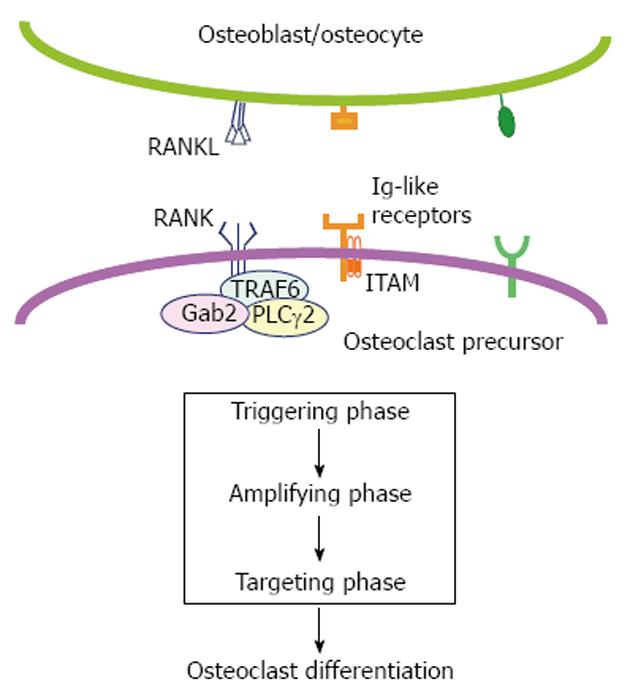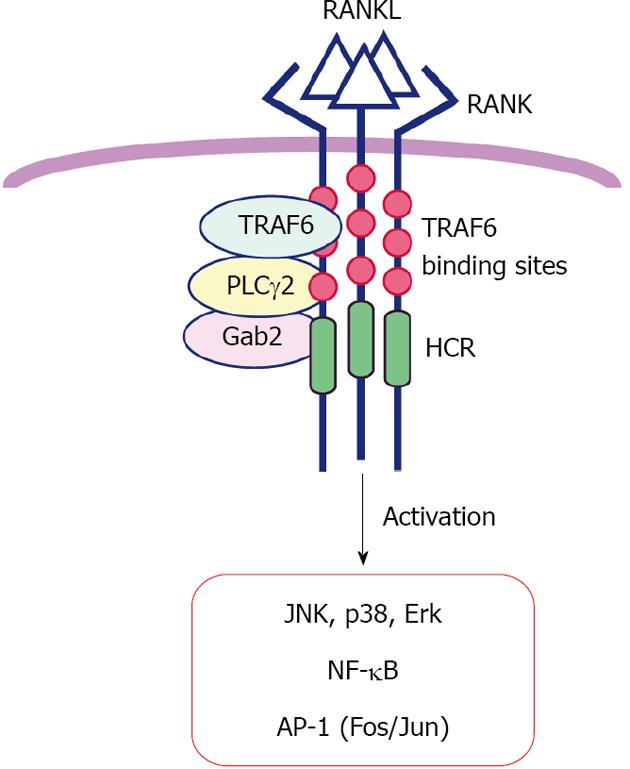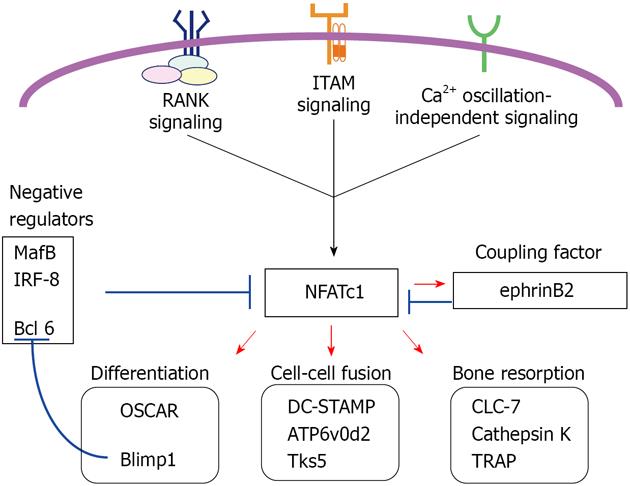Copyright
©2012 Baishideng Publishing Group Co.
World J Orthop. Nov 18, 2012; 3(11): 167-174
Published online Nov 18, 2012. doi: 10.5312/wjo.v3.i11.167
Published online Nov 18, 2012. doi: 10.5312/wjo.v3.i11.167
Figure 1 Three phases of receptor activator of nuclear factor-κB signaling during osteoclast differentiation.
Osteoclast differentiation downstream of receptor activator of nuclear factor-κB (RANK) signaling is divided into triggering, amplifying and targeting phases, based on the nuclear factor of activated T-cells cytoplasmic 1 activation state. ITAM: Immunoreceptor tyrosine-based activation motif; TRAF6: Tumor necrosis factor receptor-associated factor 6; Gab2: Grb-2-associated binder-2; PLCγ2: Phospholipase C γ2; RANKL: RANK ligand; Ig: Immunoglobulin.
Figure 2 Triggering phase.
Trimerization of receptor activator of nuclear factor-κB (RANK) by binding of RANK ligand (RANKL) immediately activates mitogen-activated protein kinases (MAPKs), nuclear factor (NF)-κB, and activator protein-1 (AP-1). An adaptor molecule complex including tumor necrosis factor receptor-associated factor 6 (TRAF6), Grb-2-associated binder-2 (Gab2) and phospholipase C (PLC)γ2 on TRAF6 binding sites of RANK is essential to induce the triggering phase. HCR: Highly conserved domain in RANK; JNK: c-Jun N-terminal kinase; Erk: Extracellular signal-regulated kinase.
Figure 3 Amplifying phase.
Both Ca2+ oscillation-dependent and -independent nuclear factor of activated T-cells cytoplasmic 1 (NFATc1) amplification are induced. Highly conserved domain in receptor activator of nuclear factor-κB (RANK)-mediated RANK signaling and immunoreceptor tyrosine-based activation motif (ITAM) signaling lead to continuous phospholipase C (PLC)γ2 activation. Regulator of G-protein signaling 10 (RGS10) determines the Ca2+ oscillation pattern through control of PLCγ2 by competitive binding of Ca2+/calmodulin and phosphatidylinositol 3, 4, 5-trisphosphate (PIP3). Sustained Ca2+ oscillation contributes to NFATc1 amplification mediated by transcriptional auto-induction. In the Ca2+ oscillation-independent pathway, Cot kinase enhances NFATc1 stabilization through direct phosphorylation and contributes to its accumulation. ER: Endoplasmic reticulum; BLNK: B cell linker protein; SLP76: Src homology 2 domain-containing leukocyte protein of 76 kD; TRAF6: Tumor necrosis factor receptor-associated factor 6; Gab2: Grb-2-associated binder-2; IP3R: IP3 receptor; CaM: Calmodulin; Btk: Bruton's tyrosine kinase.
Figure 4 Targeting phase.
Negative regulation of nuclear factor of activated T-cells cytoplasmic 1 (NFATc1) is indicated by blue lines and activation of its targets, shown in boxes, is indicated by red arrows. RANK: Receptor activator of nuclear factor-κB; ITAM: Immunoreceptor tyrosine-based activation motif; OSCAR: Osteoclast-associated receptor; Blimp1: B-lymphocyte-induced maturation protein-1; DC-STAMP: Dendritic cell-specific transmembrane protein; TRAP: Tartrate-resistant acid phosphatase; IRF-8: Interferon regulatory factor-8; MafB: V-maf musculoaponeurotic fibrosarcoma oncogene family, protein B; Bcl6: B cell lymphoma 6; CLC: Chloride channel.
- Citation: Kuroda Y, Matsuo K. Molecular mechanisms of triggering, amplifying and targeting RANK signaling in osteoclasts. World J Orthop 2012; 3(11): 167-174
- URL: https://www.wjgnet.com/2218-5836/full/v3/i11/167.htm
- DOI: https://dx.doi.org/10.5312/wjo.v3.i11.167












